 | ||
Similar Jhereg (novel), Teckla, Jhegaala | ||
Dragaeran coin animation
Dragaera is the fictional world in which a series of novels by Steven Brust is set. The word "Dragaera" can refer to the planet, the Dragaeran Empire, or its former capital, Dragaera City.
Contents
- Dragaeran coin animation
- Species
- Magic
- Sorcery
- Witchcraft
- Morganti Weapons
- Overview
- The Imperial Orb
- The Great Houses
- The Cycle
- The Paths of the Dead
- References

Species
Dragaera is inhabited by several intelligent species, including:
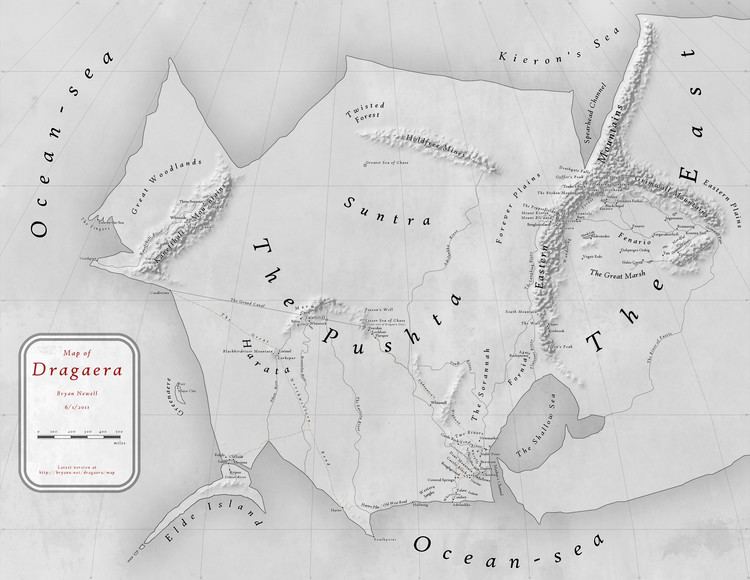
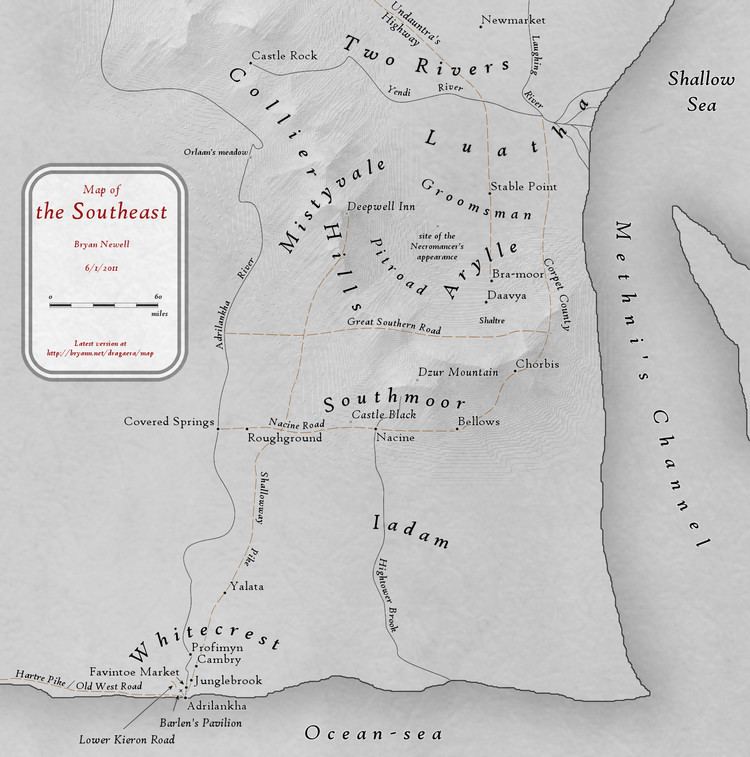
In addition, there are a number of immortal creatures that transcend the physical world of Dragaera to some degree, including:
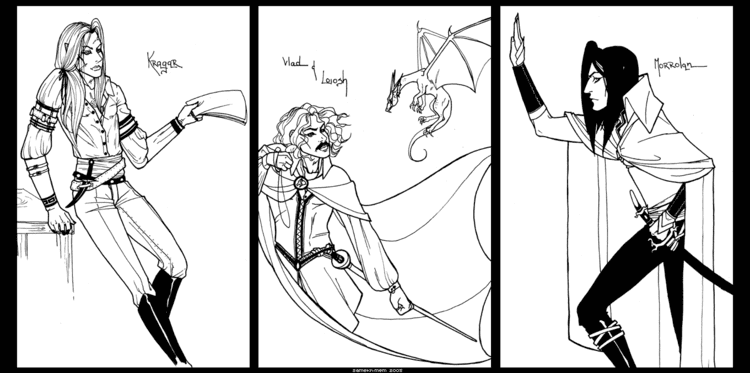
Magic
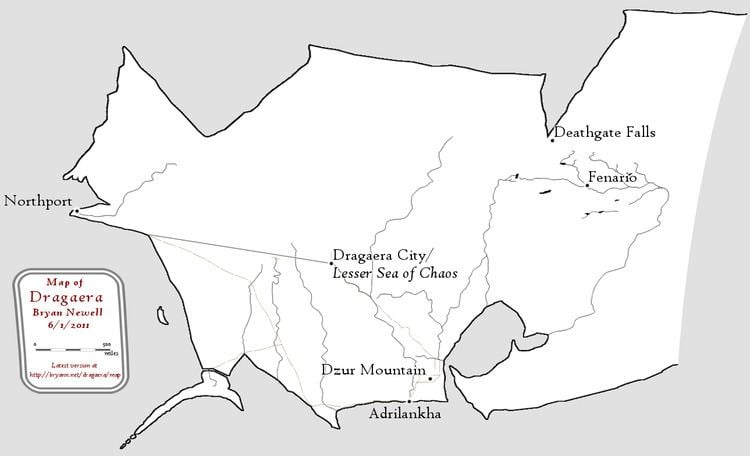
Magic exists in many forms, and is thought to have its origins in the Jenoine's manipulations of the world.
Sorcery
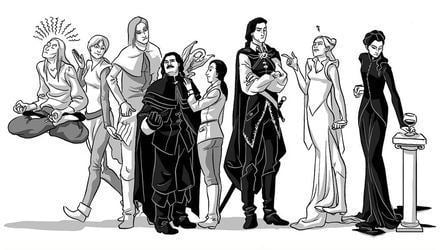
Sorcery involves gathering power from physical manifestations of chaos, shaping it into spells, and releasing it. Citizens of the Dragaeran Empire can use the Imperial Orb as a conduit to access chaos safely. The Imperial Orb itself is linked to the Great Sea of Chaos, a body of liquid chaos called amorphia. Sorcery that does not use the Imperial Orb as a conduit is called Elder Sorcery or Pre-Empire Sorcery. It is performed by converting amorphia into small stones and accessing their power directly. Elder Sorcery is much more difficult, powerful, and dangerous than standard sorcery, and it has been outlawed by the Empire. A cataclysm resulting from a mishap with Elder Sorcery, called Adron's Disaster, destroyed the former capital Dragaera City (creating a new sea of chaos in its former location) and caused an interregnum in the Great Cycle and temporary collapse of the Empire.
Before the Interregnum, sorcery was somewhat rare and less potent. During the Interregnum, the gods modified the Orb to increase the power of sorcery. Since the restoration of the Empire, sorcery has become far more common and powerful. Another theory is that it is not the Orb that was modified to make sorcery more powerful, but the extreme skill it took to work sorcery during the Interregnum lead to it being more powerful post-Interregnum. This theory is proposed by scholars, and later Verra herself. While the lower classes such as Teckla, and Easterners rarely learn any, all nobles of the Empire learn to perform at least a few basic spells. Exceptional skill takes a great deal of effort and study. Experts in any aspect of sorcery are distinguished as "wizards". Sorcery can take many shapes, but some of the most common uses include teleportation, telepathic communication, attack spells, and revivification.
Witchcraft
Used primarily by Easterners, witchcraft is a subtler form of magic that uses complex rituals to focus psychic energy. Witchcraft lacks the raw power of sorcery, but can produce some unique effects that sorcery cannot replicate. One unique ability of witchcraft is the acquisition of a familiar. Also, witchcraft can be performed with a group to enhance the power of the spell cast. Practitioners of both sexes are called "witches". Easterner witches tend to live longer than normal, and some rituals can preserve a witch's youth for hundreds of years. Other common feats of witchcraft include seeing auras, and telepathic communication.
Morganti Weapons
According to Dragaeran legend, the Serioli created Morganti weapons to make war so terrible that no one would ever start one. They are magical blades that destroy the soul of any person they cut, killing victims utterly with the smallest scratch and making resurrection or reincarnation impossible. Morganti weapons are semi-intelligent and yearn to "eat" the souls of victims. People near a Morganti weapon can feel its malevolent presence. Morganti daggers are often used by the Jhereg for particularly vindictive assassinations.
The power of Morganti weapons varies. The most powerful are called Great Weapons, which possess a number of advantages over lesser Morganti blades. Great Weapons are more intelligent and can exercise their will by choosing not to devour a soul, protecting their wielder from harm, and granting their wielder a number of magical abilities unique to the weapon. Several Great Weapons have been portrayed, including Blackwand, Godslayer (which Vlad, its owner, calls "Lady Teldra" after the Dragaeran whose personality is embedded in it), Iceflame, Pathfinder and Nightslayer. There are thought to be a total of 17 Great Weapons in existence, each with its own name and personality. They are the only weapons powerful enough to slay the Jenoine with one hundred percent certainty.
Overview
The Dragaeran Empire is the largest civilization on the planet and serves as the setting for the majority of Brust's novels set in Dragaera. It is a massive empire, covering more than half of the only known continent in the world, and has, at the point of the Vlad Taltos series, existed for about 250,000 years. It is a feudal society ruled by an Emperor or Empress from its capital city of Adrilankha, a bustling metropolis. The sky over the Empire is permanently overcast with reddish clouds due to millennia of magic usage.
The Empire has the feel of Western Europe around the time of the Reformation, but uses magic as a replacement for most technology. Despite the Empire's vast age, its culture has been remarkably stable, evolving only slowly. This is due in part to the very long lives of Dragaerans, in part to an ingrained respect for tradition, and in part to the meddling of the Dragaeran gods.
The Empire is frequently at war with neighboring Dragaeran kingdoms as well as the Eastern Kingdoms. Warfare is handled through a combination of swordsmanship and sorcery. Soldiers rarely wear armor, as metal attracts sorcery. Bows and other mundane projectile weapons are extremely rare. Due to the almost complete lack of gender role differentiation in Dragaeran society, women are just as likely to be found in the military as any other profession.
The Imperial Orb
The Orb is a floating, glowing sphere of enormous magical power that serves as the source of the Emperor's authority and the linchpin of the Empire. The Orb and the reigning Emperor share an almost-unbreakable magic link. The Orb will protect the Emperor from almost all harm, making him or her virtually immune to assassination. The Emperor can consult the memories of all previous emperors through the Orb. The Orb constantly changes colors to reflect the Emperor's current mood. All citizens of the Empire are linked to the Orb as well, and can use it to access sorcery. The Orb also performs more mundane services such as broadcasting the precise time of day and serving as a lie detector during Imperial trials.
According to legend, the Orb was created by Zerika the First, a co-founder of the Empire and the first Empress. Another theory is that the Orb was created by the Jenoine but activated or usurped by Zerika. It is not completely understood by most Dragaerans, though it is believed to be indestructible.
To save the Orb from Adron's Disaster, the Orb was transported to the Paths of the Dead. Empress Zerika IV retrieved it from there, ending the interregnum period.
The Great Houses
All citizens of the Empire are divided into seventeen houses, each represented by an animal. It is believed there were as many as twenty-three in earlier times, but that some houses have since died out. It is also believed that the members of each House (except for the Jhereg) are descended from Dragaerans that were mingled most prominently with their House's animal when the Jenoine created the species. With few exceptions, membership in a House is determined by birth. Most Dragaeran Houses resemble clans, with all members of a given House related by blood. Certain facial features are strongly associated with most Houses, and most Houses have official colors that members wear prominently, making the House membership of most Dragaerans visually apparent. In addition, certain temperaments, talents, and vocations are strongly associated with each House. Mating outside of one's House is taboo among Dragaerans, and half-breeds are considered outcasts. The House of the Jhereg, founded by mixed-house outcasts, is an exception to both of these rules: noble titles in the House of the Jhereg can be bought for a suitable bribe, and half-breeds are not looked upon so severely.
The peasants of the Empire come from the House of the Teckla, forming 90% of the Empire's population. Anyone who swears allegiance on the Orb can become a citizen of the Empire as a Teckla, including Easterners. All Houses but the Teckla are considered Noble Houses, though some are more noble than others. Members of the lower Houses, including the Jhereg, Orca, and Chreotha, form the Empire's middle class, working as merchants and artisans. The intermediate Houses, including the Athyra, Yendi, and Issola, tend to work as academics and professionals. Between five and seven of the most noble Houses, depending on opinion, make up the "true aristocracy" of the Empire, such as Phoenix, Dragon, Dzur, and Tiassa.
The animals representing each House are unique to the world of Dragaera. Those that share a name with a real or mythical animal of Earth are not the same creature.
The Great Houses are as follows (in order of their precedence in the cycle), with their two primary representative characteristics.
The Cycle
The Cycle is a magically-spinning wheel in the Halls of Judgment that controls the reign of the Emperor and the political fate of the Houses. Each of the 17 Houses is represented along the wheel. When a House reaches the top of the wheel, it chooses one of its members to reign as Emperor. When the wheel turns enough to bring the next House to the top, the former Emperor relinquishes the throne, willingly or not, and a new one reigns. The House of a former Emperor becomes "descending" and loses power until it reaches the bottom of the Cycle. After a House rounds the bottom, it becomes "rising", gaining power until it reaches the top and reigns again. The order of the Houses along the Cycle is: Phoenix, Dragon, Lyorn, Tiassa, Hawk, Dzur, Issola, Tsalmoth, Vallista, Jhereg, Iorich, Chreotha, Yendi, Orca, Teckla, Jhegaala, Athyra. The order is structured so that each Emperor is naturally suited to fix the mistakes of the previous Emperor, thus keeping the Cycle constantly spinning. A notable exception is the peasant House of the Teckla, which institutes a short-lived republic during its reign.
The figurative role of each house in the Cycle is described in the Cycle Poem, which is printed as an epigraph in several books of the series and makes various appearances in the stories.
Where the Cycle came from, what makes it turn, and how exactly it is linked to the Empire is not completely understood. The Cycle turns at varying speeds for unknown reasons, but a reign is never shorter than 289 (17^2) years, and never longer than 4,913 (17^3) years. Determining when the Cycle shifts is a matter of magic and guesswork because living citizens almost never physically see the Cycle. The next House on the Cycle often attempts to seize power when it believes the Cycle has shifted. If the House succeeds, this is taken as proof that it was right. It was also said that if a person can go to the Cycle and is strong enough to turn it, then the Cycle will truly change.
During the time of the Vlad Taltos series, there is only one remaining member of the House of the Phoenix, causing some characters to question whether the Cycle can continue.
The Paths of the Dead
When Dragaeran citizens of the Empire die, their souls go to the Paths of the Dead, a physical labyrinth in the Greymist Valley of Dragaera. Bodies are generally sent over the Blood River at Deathsgate Falls to facilitate the soul's entrance. Each House has its own path and trials that its members must face. At the end of the Labyrinth are the Halls of Judgment, where the Lords of Judgment sit and determine the fate of Dragaeran souls that reach them. Those they deem worthy for their own uses are allowed into the next state of being. Those they reject are reincarnated or bound to serve in the Halls. It is possible for living creatures to enter the Paths, but it is extremely difficult to leave. Very rarely, Dragaerans will become undead to leave the Halls without reincarnating.
